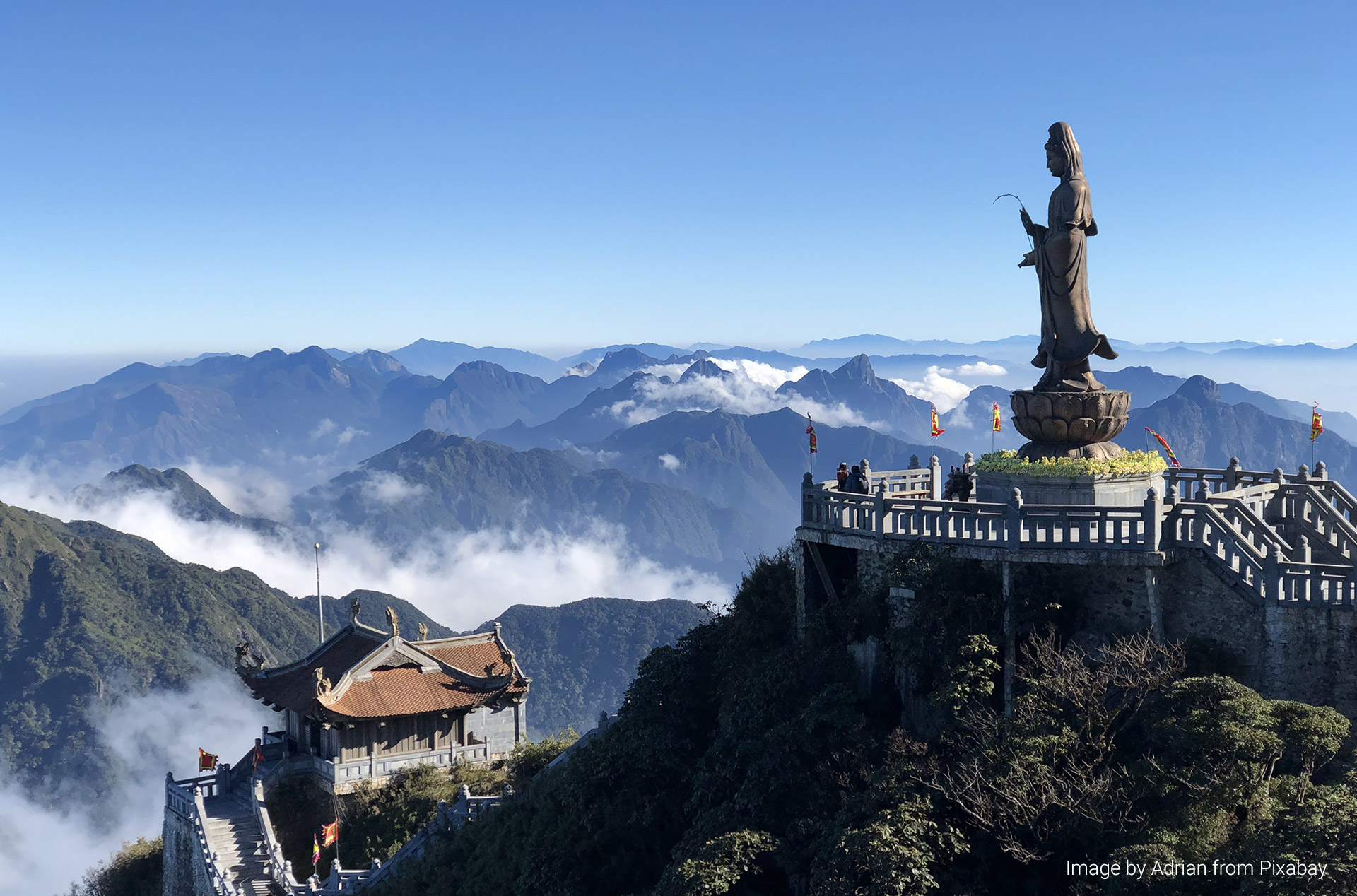
- On 15/07/2023
- In Blogs Travel Tips
- Tags:
The majestic Northwest of Vietnam
Extracted from: BaoTuyenQuang.com.vn, VnExpress.net, fansipanlegend.sunworld.vn. Photo credit: Sun Group, Lê Việt Khánh, Nguyễn Minh Tú, Vũ Minh Quân
The Northwest region with its magnificent nature, unique culture and heroic history is a an irresistible charm with its breathtaking natural scenery. The most rugged high mountain region in Vietnam, the Northwest is a seamless mass of mountains and rivers—is structured in the direction of Northwest-Southeast parallel to the Red River valley. From East to West is marked by the 180km long Hoang Lien Son Mountain Range with the highest peak of Fansipan in Sapa with an elevation of 3,143 meters above sea level.

A sacred symbol of our nation, the Flagstaff on the Fansipan rises 25m tall. It was meticulously and solidly constructed out of Thanh Hoa green marbles, four timber species and a exclusively ordered fabric. The pedestal of the flagstaff is studded with sophisticated bas-reliefs that reenact the essences of Vietnamese culture, including the Cham Towers, Central Highlands stilt houses, Northwestern cultures or the new world natural wonder of Ha Long Bay…
The Fansipan is located in Hoang Lien Mountain Range, and the tallest mountain in the three Indochinese countries of Vietnam, Laos and Cambodia, thus the sacred convergence of the heaven and the earth, long coined as the “Roof of Indochina” at the height of 3,143m. Topping the Fansipan is always a desire for outdoor enthusiasts and those with itchy feet.

In their introduction of Sapa Town, Rough Guides aroused curiosity and sentiments of their readers with this description: “Adventure lovers may ge well aware of this destination, which always makes our hearts skip a beat at the sight of this characteristic landscape of Southeast Asia. Discovered by the French in the 1920s as a retreat from the broiling summer of the North, Sapa rose to prominence and was gradually crowded in recent years, but extreme experiences are simply here to stay. Climbing up rice terraces on slopy Muong Hoa Valley, staying overnight on mist drenched hills or taking over the Fansipan – the Roof of Indochina under the falling sunset are some of the more rewarding experiences”.

Sapa, well famous in the eyes of international visitors as the “town in clouds, is even more alluring with its magnificent nature, breathtaking Muong Hoa Valley and towering Hoang Lien Mountains wrapped in the oceanic clouds cascading down the earth. In particular, with Fansipan cable car route to the Fansipan and Muong Hoa Hiking Train that departs from heart of the town, visitors are now granted greater access to a panorama of the town and undulating mountains from up high.
The race to the Fansipan – Roof of Indochina in Vietnam aboard three wire cable cars carries visitors to lapses of billowing clouds, vast swathes of pristine primordial forests meandering around Muong Hoa concave valley and towering mountains of Hoang lien. Through glittering windowpanes, the tapestry of colorful azaleas in springtime or glinting undulating rice terraces of gold in autumn, seemingly well within our reach.
The sinuous mountain trek trodden by motorbikes, or even on foot to admire villages and mountains of Sapa is also a great pleasure. Hamlets such as Ta Van, Ta Phin and Lao Chai… welcome strangers with their amazing ethnic lifestyle and tranquil huts bogged in dim cooking smoke, and rich experiences rarely found elsewhere.

In recent years, Sapa is even more corwded because atop the Fansipan lies a complex of grave and solemn religious landmarks that rise above eternal mounts, which intensifies our experiences of divinity on this borderline land. In the midst of the demure Zen sphere, bell sounds echo in the mountain breezes. Standing down the Amitabha Buddha Statue – the tallest copper Buddha statue of Vietnam or GUanyin Statue to pray for peace of mind and happiness, just listen to your hearts and keep calm to the conical milestone of 3,143m, a clear manifesto of your journey to the legendary “Roof of Indochina”.
Sometimes, northewestern aura appears long around Kim Son Bao Thang Pagoda and Guanyin Buddha Statue, as if Buddha appeas on earth in this fountain of sacred power of our country. These miraculous natural phenomena are hardly seen anywhere other than the Fansipan.
The Great Amitabha Buddha statue located at a pagoda complex on Mount Fansipan in highlands resort town Sa Pa has set a world record. It was recognized as the copper statue located at the highest altitude in Asia by Guinness World Records, the global authority on record-breaking achievements.
The starting site among the compound called Bao An Zen Monastery (or Trinh Pagoda) is located at an altitude of 1,604m above sea level, close to the Fansipan cable car station, in the west of the city center of Sa Pa. This is the first stop for visitors on the journey to conquer the roof of Indochina and pilgrimage to contemplate spiritual cultural ensemble.

Due to the high level of ethnic diversity in the district, there are many cultural festivals held throughout the year in Sapa. The majority of the ethnic groups in Vietnam subscribe to ancestor worship as well as the worship of spirits said to control different aspects of life such as weather or the harvest. Besides their daily rituals, there are many colourful and exciting festivals that serve as a way to worship and give thanks to these spirits.
In autumn, Fansipan's enchanting beauty is highlighted by rolling clouds. Looking down from the peak, you can see a beautiful strip of clouds. Sometimes, the clouds dissipate, revealing the dreamy scenery of Sapa.

In winter, the temperature on the top of Fansipan can drop to -9°C and snow appears. Visitors coming here will have the opportunity to photograph a blanket of snow up to half a meter thick in a tropical Southeast Asian country. At Christmas, the snow covers the whole area of Fansipan and Sapa creating a spectacular and beautiful white area to have a wonderful and unique series of winter photos right here in Vietnam.
Enjoy the festivals in Sapa for all the year-round: Roong Pooc: This festival started with the Giay people and is celebrated in early January of the Lunar calendar. The atmosphere is jovial, and delicious food and drink is served throughout its duration; Nao Cong: Taking place in June on the Lunar calendar by people of the H’mong, Dao and Giay villages in Moung Hoa Valley; Tet Nhay: Tet Nhay Festival is a Dao celebration held during the National Holiday of Tet, which is celebrated throughout Vietnam; Gau Tau: Gau Tau is a H’mong festival organized by individual families within the community, taking this responsibility in turns.

Along with the magnificent natural landscape, the traditional culture of the ethnic groups is also a highlight in the tourism resources here. The Northwest is home to many ethnic groups such as Tay, Nung, Thai, Muong, Mong, Dao, Kinh, Hoa, Kho Mu, Lao, Lu, Ha Nhi, Khang, La Hu, Si La, Phu La, and Bo Y. , Mang, Giay, Lo Lo, Pa Then, Phu La, Co Lao, La Chi... with a large and rich cultural space.
Visitors can enjoy a variety of mountainous delicacies in Sa Pa town such as thang co (a H’mong dish cooked from horse meat, beef and offals), grilled pork, com lam (rice grilled in bamboo hollow tubes), chicken and waterfall’s fish. To cope with the cold weather in the high altitude, visitors can opt for a hotpot of salmon or sturgeon. Visitors can also enjoy the exotic cuisine of the mountainous area with traditional dishes of the North West such as Sa Pa sausage, Bac Ha noodle soup, dried beef, steam sticky rice, prepared by ethnic people in the market area near Fansipan cable car station.

Far from Vietnam’s popular beach resorts, massive metropolises, and teeming World Heritage Sites, Sapa is a (relatively) quiet mountain town near the Chinese border. It’s known for mountain vistas, shockingly green rice terraces, and the proximity to waterfalls and hiking trails.
Extracted from: BaoTuyenQuang.com.vn, VnExpress.net, cntraveler.com
Thiên Xuân Travel
📨 booking@thienxuantravel.com
☎️ +84 888 890 898 — 0938 558 228
🔖 #thienxuantravel

